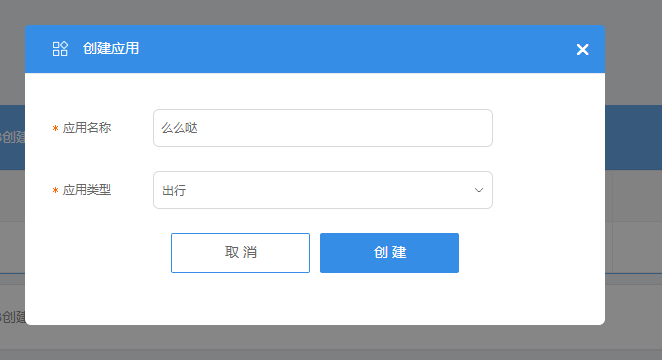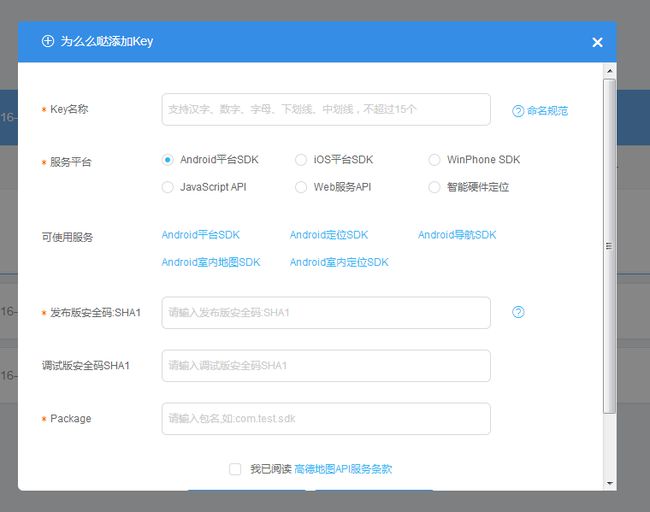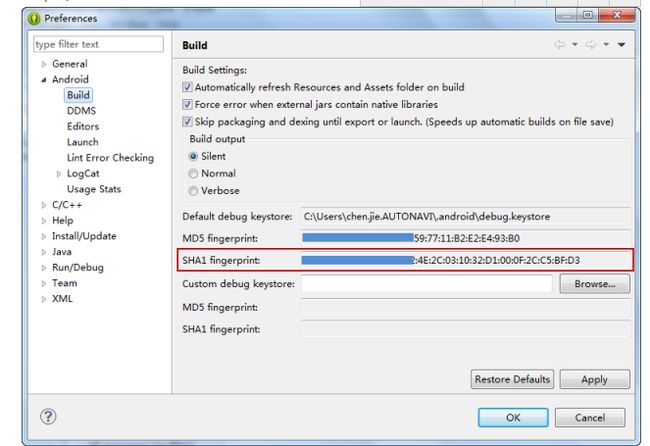Android高德地图开发流程
夫天地者,万物之逆旅也;光阴者,百代之过客也,不知不觉,已过去了无数岁月,本人一心修仙,然仙道漫漫... 好了,凭什么就打我,他们也在装逼啊........
咳咳,装逼完毕,进入正题,很多刚刚开始搞第三方SDK接入的同学都操蛋这第三方的东西这个不好,那个不好,其实我想对这些嫌这嫌那的人说,没错,真tm烂。
这次真的正题了.... 首先我们进入高德地图主页,进入控制台:
会看到如上所示,我们先创建应用,然后我们点击右侧添加新Key会出现如下,
这个时候 会看到一堆乱七八糟的东西让我们来写,管他三七二十二,都一个个填了,当填到SHA1 的时候,一脸懵比,这什么鬼,好的别急 哥告诉你们在哪,发布版本的SHA1码就在我们eclipse里面,自己找一下,
这个时候,把这个SHA1 复制到测试版本里面去,然后需要正式发布的版本,这个就比较尴尬了,怎么弄呢,不急,
在控制台中如下输入,然后到了输入密码库口令这一步,哎呦,卧槽,我明明输入了密码,怎么没用,什么鬼,别急,DOS下输入密码的时候就是不显示,你就直接把你的密码输入进去,确定,OK,成了,如下:
好的,这个就是我们所需要的了,把这个复制到正式版本的那一栏,点击确定,OK,我们成功创建了高德地图所需要的应用,接下来就是正式作战了, 我以高德地图地位功能做详细解释,首先,下载高德地图的Demo (Demo对于我们这一代起至关重要的作用,慢慢的也许我们就可以卸下这一款大石头),下载完之后,就是导入到我们的eclipse里面,
做到这里的时候,你已经完成了1%......
这个时候,我们所要考虑的是如何把高德地图的这个定位功能 搞到我们的项目里面呢,好的,第一步,进入到它的Manifest.xml文件,把它所需要的权限啊,和其他一些乱七八糟的全部 搞到自己的项目中,就地位功能来说,我们需要如下东西,
如上两个图所示,我们需要定位所需要的服务service 以及meta-data(在这个里面写上我们之前在高德地图创建应用成功之后给我们的appkey),和权限(权限重复的可以去掉), 好了,当这里配置好以后,我们需要导入需要的jar包,
好的,把这个jar包复制到我们的libs下,然后开始搞代码,我们需要定位功能,所以,进入它的Activity
package com.amap.location.demo;
import android.app.Activity;
import android.os.Bundle;
import android.os.Handler;
import android.os.Message;
import android.text.TextUtils;
import android.view.View;
import android.view.View.OnClickListener;
import android.widget.Button;
import android.widget.CheckBox;
import android.widget.EditText;
import android.widget.RadioButton;
import android.widget.RadioGroup;
import android.widget.RadioGroup.OnCheckedChangeListener;
import android.widget.TextView;
import com.amap.api.location.AMapLocation;
import com.amap.api.location.AMapLocationClient;
import com.amap.api.location.AMapLocationClientOption;
import com.amap.api.location.AMapLocationClientOption.AMapLocationMode;
import com.amap.api.location.AMapLocationListener;
/**
* 低功耗定位模式功能演示
*
* @创建时间: 2015年11月24日 下午4:24:07
* @项目名称: AMapLocationDemo2.x
* @author hongming.wang
* @文件名称: Battery_Saving_Activity.java
* @类型名称: Battery_Saving_Activity
*/
public class Battery_Saving_Activity extends Activity implements
OnCheckedChangeListener, OnClickListener, AMapLocationListener {
private RadioGroup rgLocation;
private RadioButton rbLocationContinue;
private RadioButton rbLocationOnce;
private View layoutInterval;
private EditText etInterval;
private CheckBox cbAddress;
private TextView tvReult;
private Button btLocation;
private AMapLocationClient locationClient = null;
private AMapLocationClientOption locationOption = null;
@Override
protected void onCreate(Bundle savedInstanceState) {
super.onCreate(savedInstanceState);
setContentView(R.layout.activity_battery_saving);
setTitle(R.string.title_battery_saving);
rgLocation = (RadioGroup) findViewById(R.id.rg_location);
rbLocationContinue = (RadioButton)findViewById(R.id.rb_continueLocation);
rbLocationOnce = (RadioButton)findViewById(R.id.rb_onceLocation);
layoutInterval = findViewById(R.id.layout_interval);
etInterval = (EditText) findViewById(R.id.et_interval);
cbAddress = (CheckBox) findViewById(R.id.cb_needAddress);
tvReult = (TextView) findViewById(R.id.tv_result);
btLocation = (Button) findViewById(R.id.bt_location);
rgLocation.setOnCheckedChangeListener(this);
btLocation.setOnClickListener(this);
locationClient = new AMapLocationClient(this.getApplicationContext());
locationOption = new AMapLocationClientOption();
// 设置定位模式为低功耗模式
locationOption.setLocationMode(AMapLocationMode.Battery_Saving);
// 设置定位监听
locationClient.setLocationListener(this);
}
@Override
protected void onDestroy() {
super.onDestroy();
if (null != locationClient) {
/**
* 如果AMapLocationClient是在当前Activity实例化的,
* 在Activity的onDestroy中一定要执行AMapLocationClient的onDestroy
*/
locationClient.onDestroy();
locationClient = null;
locationOption = null;
}
}
@Override
public void onCheckedChanged(RadioGroup group, int checkedId) {
switch (checkedId) {
case R.id.rb_continueLocation:
//只有持续定位设置定位间隔才有效,单次定位无效
layoutInterval.setVisibility(View.VISIBLE);
//设置为不是单次定位
locationOption.setOnceLocation(false);
break;
case R.id.rb_onceLocation:
//只有持续定位设置定位间隔才有效,单次定位无效
layoutInterval.setVisibility(View.GONE);
//设置为单次定位
locationOption.setOnceLocation(true);
break;
}
}
/**
* 设置控件的可用状态
*/
private void setViewEnable(boolean isEnable) {
rbLocationContinue.setEnabled(isEnable);
rbLocationOnce.setEnabled(isEnable);
etInterval.setEnabled(isEnable);
cbAddress.setEnabled(isEnable);
}
@Override
public void onClick(View v) {
if (v.getId() == R.id.bt_location) {
if (btLocation.getText().equals(
getResources().getString(R.string.startLocation))) {
setViewEnable(false);
initOption();
btLocation.setText(getResources().getString(
R.string.stopLocation));
// 设置定位参数
locationClient.setLocationOption(locationOption);
// 启动定位
locationClient.startLocation();
mHandler.sendEmptyMessage(Utils.MSG_LOCATION_START);
} else {
setViewEnable(true);
btLocation.setText(getResources().getString(
R.string.startLocation));
// 停止定位
locationClient.stopLocation();
mHandler.sendEmptyMessage(Utils.MSG_LOCATION_STOP);
}
}
}
// 根据控件的选择,重新设置定位参数
private void initOption() {
// 设置是否需要显示地址信息
locationOption.setNeedAddress(cbAddress.isChecked());
String strInterval = etInterval.getText().toString();
if (!TextUtils.isEmpty(strInterval)) {
/**
* 设置发送定位请求的时间间隔,最小值为1000,如果小于1000,按照1000算
* 只有持续定位设置定位间隔才有效,单次定位无效
*/
locationOption.setInterval(Long.valueOf(strInterval));
}
}
Handler mHandler = new Handler(){
public void dispatchMessage(android.os.Message msg) {
switch (msg.what) {
case Utils.MSG_LOCATION_START:
tvReult.setText("正在定位...");
break;
//定位完成
case Utils.MSG_LOCATION_FINISH:
AMapLocation loc = (AMapLocation)msg.obj;
String result = Utils.getLocationStr(loc);
tvReult.setText(result);
break;
case Utils.MSG_LOCATION_STOP:
tvReult.setText("定位停止");
break;
default:
break;
}
};
};
// 定位监听
@Override
public void onLocationChanged(AMapLocation loc) {
if (null != loc) {
Message msg = mHandler.obtainMessage();
msg.obj = loc;
msg.what = Utils.MSG_LOCATION_FINISH;
mHandler.sendMessage(msg);
}
}
}
这个Activity里面基本包含了我们所需要的功能,首先我们也实现他所需要的接口,
然后我们看,当点击开始定位 这个按钮时,它做了哪些事情,
initOption();
btLocation.setText(getResources().getString(
R.string.stopLocation));
// 设置定位参数
locationClient.setLocationOption(locationOption);
// 启动定位
locationClient.startLocation();
mHandler.sendEmptyMessage(Utils.MSG_LOCATION_START);这些东西包含了定位所需要的一切东西,我们也按照它的做,做完后,它用handler发送了数据,在这个 handler里面接收到的数据里面就有我们所需要的经度纬度,我们继续追踪这个handler,
OK,找到了,在这里,它把数据显示在了一个textview里面,好的,我们点进Utils.getLocationStr(loc)方法查看
,
public synchronized static String getLocationStr(AMapLocation location){
if(null == location){
return null;
}
StringBuffer sb = new StringBuffer();
//errCode等于0代表定位成功,其他的为定位失败,具体的可以参照官网定位错误码说明
if(location.getErrorCode() == 0){
sb.append("定位成功" + "\n");
sb.append("定位类型: " + location.getLocationType() + "\n");
sb.append("经 度 : " + location.getLongitude() + "\n");
sb.append("纬 度 : " + location.getLatitude() + "\n");
sb.append("精 度 : " + location.getAccuracy() + "米" + "\n");
sb.append("提供者 : " + location.getProvider() + "\n");
if (location.getProvider().equalsIgnoreCase(
android.location.LocationManager.GPS_PROVIDER)) {
// 以下信息只有提供者是GPS时才会有
sb.append("速 度 : " + location.getSpeed() + "米/秒" + "\n");
sb.append("角 度 : " + location.getBearing() + "\n");
// 获取当前提供定位服务的卫星个数
sb.append("星 数 : "
+ location.getSatellites() + "\n");
} else {
// 提供者是GPS时是没有以下信息的
sb.append("国 家 : " + location.getCountry() + "\n");
sb.append("省 : " + location.getProvince() + "\n");
sb.append("市 : " + location.getCity() + "\n");
sb.append("城市编码 : " + location.getCityCode() + "\n");
sb.append("区 : " + location.getDistrict() + "\n");
sb.append("区域 码 : " + location.getAdCode() + "\n");
sb.append("地 址 : " + location.getAddress() + "\n");
sb.append("兴趣点 : " + location.getPoiName() + "\n");
}
} else {
//定位失败
sb.append("定位失败" + "\n");
sb.append("错误码:" + location.getErrorCode() + "\n");
sb.append("错误信息:" + location.getErrorInfo() + "\n");
sb.append("错误描述:" + location.getLocationDetail() + "\n");
}
return sb.toString();
}







